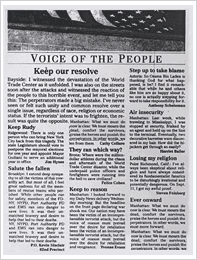The fourth reason for the increased appreciation was that the media provided a public sphere for communication. Through the media, people could communicate with each other, or communicate with experts who could help them deal with the crisis. Immediately after September 11, quite a few television and radio stations organized electronic town-hall meetings. People could participate in the discussion at these meetings by calling in or by sending e-mail messages. Many viewers and listeners appreciated the opportunity to access these forums.
 |
|
| Letters-to-the-editor sections, such as this "Voice of the People" in the New York Daily News on September 14, 2001, provided a forum for broad and diverse public debate. | |
If newspapers and news magazines did not actually expand their letters-to-the-editor sections, they certainly devoted that space for weeks to readers whose comments related to the crisis. These columns provided another opportunity to make use of a public space. I have closely followed letters-to-the-editor sections of the print media for years and I do not remember ever having seen such a full, broad, and diverse public debate as in the weeks and months after September 11.
People also probably appreciated the gatekeeper role served by certain people in the media. Editors, producers, and others filter out certain communications by readers, viewers, and listeners. To fully appreciate that role, compare the letters-to-the-editor sections with Internet chat rooms and discussion boards. None of the online resources I have followed have ever reached the high quality of discourse that occurred in the letters-to-the-editor sections and in the media's electronic town-hall meetings.